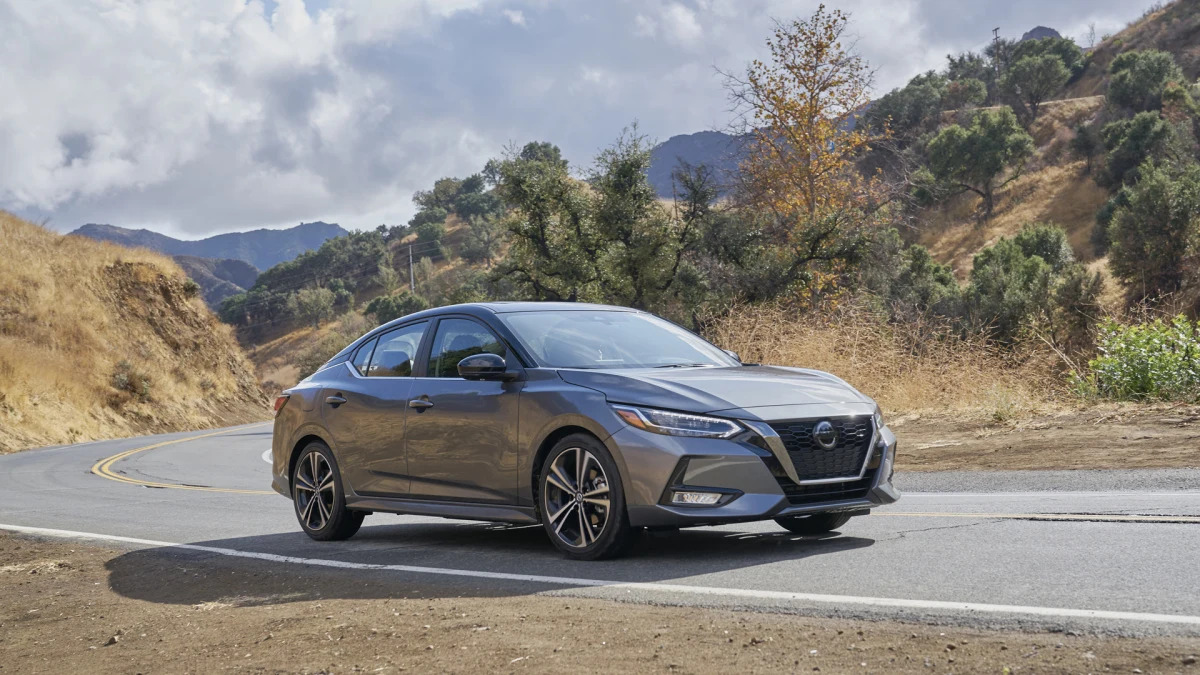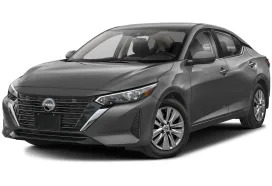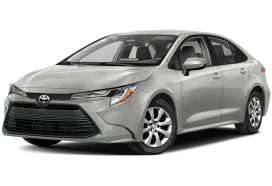SANTA MONICA, Calif. — If the sedan really is dead in America, Nissan hasn’t gotten the memo. The 2020 Nissan Sentra is reaching dealers alongside the equally all-new Versa, and just last year Nissan facelifted the Maxima and launched the sixth-generation of the midsize Altima. This is all happening as sales of four-door cars continue to fall and some brands kill off their sedans to focus on red-hot crossovers.
Although the Sentra is the automakers best-selling model of all-time and Nissan has sold over 200,000 annually since 2015, the last generation’s homely sheetmetal, plasticky interior and weak 1.8-liter engine were, to put it kindly, uninspired. This time around, things are different. The new eighth generation of the compact sedan looks, drives and feels like Nissan’s design and engineering teams actually took some pride in their work.
For starters it no longer looks like it was designed in the dark. With a ruler. As is the case with the Altima and the new Versa, the Sentra has now taken much of its styling from the current Maxima, which was launched in 2016. Beautiful? Not exactly. A little busy for some taste? Maybe. But it isn’t boring and it’s thankfully lost all of its upright narrowness and frumpy proportions.



Unquestionably more dynamic, the new look has widened the car 2.2-inches, lowered its roof 2.0-inches and stretched its wheelbase half an inch. At 182.7 inches, it’s also about half an inch longer than before, but remains nearly 10 inches shorter than an Altima. Nissan is even offering several two-tone options that paint the top Super Black for an effect that’s presently all the rage.
Considerable effort was also made upgrading the Sentra’s interior. A driver’s seat that’s a bit lower than before provides a sportier driving position, and a thick flat-bottom steering wheel is standard. Its new seats are more comfortable and have more aggressive bolsters. Rear seat space remains about the same and still lags behind the Honda Civic, which is the stretch limo of the class, and its trunk has shrunk from 15.1 cubic feet to 14.3. That’s a bit larger than the trunk of the Toyota Corolla and a bit smaller than the Civic’s. A 60/40 split folding rear seat is standard.
All the materials have also been radically improved. The dash is no longer a sea of black plastic and its new design features knurled climate control knobs and round air conditioning vents like you get in a Mercedes or a Kia Stinger. A 7-inch touchscreen is standard on the base Sentra S, while the SV and SR have 8-inch units. Apple CarPlay and Android Auto are standard across the line. The only interior miscue is the sedan’s foot-operated parking brake, which feels dated even for this price point.



Now on a new platform, the 2020 Sentra adopts an independent rear suspension. Only units sold in China keep the beam axle sabotaged recent Sentras’ handling, ride and response. Stephen Soley, Nissan’s vehicle program development manager, began tuning the 2020 Sentra in early 2017. “From an overall handling perspective we targeted the Honda Civic,” he says. “But not from a noise, vibration and harshness perspective, for those targets we focused on the VW Golf.”
There’s also a new steering system, which is standard on all three trim levels. This is the first Sentra with the dual-pinion electric power steering system also used in the Altima. It increases steering effort at higher speeds for improved feedback and control. Although the effort is a bit high around town, it feels right when pushing the sedan through corners, and it has the same quick 15.3:1 steering ratio as the Altima. Steering feel, which Soley said was also targeting the Golf, is radically improved.
Chassis hardware and tuning is the same across the board, with a few exceptions. The base Sentra S gets 9-inch rear drum brakes, while the SV and SR have four-wheel discs with vented 10-inch rotors in the rear. The wheels and all-season tires are specific to the trim levels. The Sentra S and SV ride on 16-inch rubber (17-inch tires are available on the SV), while the SR gets 18s.
Our SR test vehicle rode on 215/45R18 Hankook Kinergy GT tires that showed impressive grip and response in the hills above Malibu, California. Although 61% of the SV’s 3,084 lbs is up front, the Sentra feels balanced and understeers only mildly. Active Understeer Control System, which lightly applies the inside front brake during cornering, is standard on all trim levels and goes about its business in a stealthy manner. Although its braking performance was satisfactory both in and out of the city, pedal action was a bit mushy.



The Sentra’s aggressive chassis tuning will surprise some. It’s firm for this class with quite a bit of roll stiffness thanks to 22.2 mm front and 26.5 mm rear sway bars. With the 18-inch tires its ride is comfortable, but it’s definitely sportier than it is plush. And its new lower center of gravity and 2.4-inch wider track, the Sentra feels solid and stable when you toss it around, especially in faster wide-open corners where it soaks up mid-corner bumps well. It’s refined and quiet inside, but not overly isolating.
“The outgoing Sentra wasn’t the most exciting, so we wanted to overcompensate [by] adding performance and personality,” says Soley.
Engine displacement and power are up as well. Now every Sentra gets the same naturally aspirated all-aluminum DOHC 2.0-liter and continuously variable transmission as the Rogue Sport. With 149 horsepower at 6,400 rpm and 146 pound-feet of torque at 4,400 rpm the engine produces 20% more power and 17% more torque than last year’s 1.8-liter. It’s also smoother with much more mid-range power between 3,000 rpm and 5,000 rpm.
For even more punch, Nissan also shortened the Sentra’s final-drive ratio from 3.517:1 to 5.250:1 and retuned its CVT for better response. It no longer makes you beg for a downshift and its gear changes, although still rubber-bandy, feel more natural than they used to. There’s a Sport mode that tightens the engine’s throttle response and retunes the transmission to hold lower ratios longer at part throttle.

Unfortunately, the CVT remains a fun killer in a car that’s otherwise dynamically well sorted. At wide open throttle it upshifts every virtual gear at 5,800 rpm, well short of the engine’s 6,400-rpm power peak or 6,600-rpm redline. And in the hills its ratio changes are poorly timed. Manual control over the “gears” would help, but there are neither paddle shifters nor a manual gate on its shifter. In Canada and Mexico, the Sentra S will be offered with a six-speed manual, but not in the United States.
Despite the larger and more powerful engine, plus an average weight gain of about 150 lbs, the Sentra’s EPA’s fuel economy estimates are about the same as last year – 29 miles per gallon city and 39 mpg highway. The SR’s additional 44 lbs and 18-inch tires drop those numbers to 28 mpg city and 37 mpg highway.
Base price for a Sentra S is now $20,015, which is only about $400 more than last year. At $21,195, the SV is a better value, while the SR costs $22,355. For $25,325 our loaded SR test vehicle featured two-tone paint and the Premium Package, which includes a sunroof, heated seats and a heated steering wheel. Every trim level comes with Automatic Emergency Braking with Pedestrian Detection, Blind Spot Warning, Rear Cross Traffic Alert, Lane Departure Warning that vibrates the steering wheel, High Beam Assist and Rear Automatic Braking.

According to Nissan, which has sold over six million Sentras in the United States since 1982, 78% of American drivers who don’t own a sedan would consider buying one, and that number jumps to 86% of those between 18-34 years old. Of course, if current market trends continue, most of those consumers will buy an SUV instead. But for those that do decide that a sedan is right for them, the new 2020 Nissan Sentra is worth checking out. It’s undeniable proof that Nissan can still build an appealing small car when it wants to.













Sign in to post
Please sign in to leave a comment.
Continue